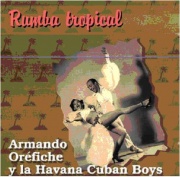10.7.9 Havana Cuban Boys.

Havana Cuban Boys, a prominent Cuban popular music orchestra founded by Armando Oréfiche and based on the Lecuona Cuban Boys.
With music by the renowned Cuban musician Ernesto Lecuona, the Lecuona Cuban Boys orchestra, directed by Oréfiche, made its debut in 1946 in the Hollywood production “Carnival in Costa Rica.” After this performance, disagreements began to emerge within the group.
The orchestra remained under the tutelage of Gerardo Bruguera after its director left; he created another group that same year called Havana Cuban Boys. He was accompanied on this feat by other prestigious musicians, namely Arnaldo Chiquitico Oréfiche and Chico O’Farrill.
After the new orchestra was formed, they achieved several successes in the United States and European countries. They recorded under the Panart label, and their works inspired by their conductor, performed by Bola Nieve, were notable.
Also very relevant were the performances with Bebo Valdés and with Ricard Roda, of Catalan origin, who would later join the group in those years, along with other foreign artists such as Paraguayan Rubén Alejandro González and Venezuelan Francisco Hernández, universally known as “El Pavo Frank.”
Around that time, Havana Cuban Boys opened the Moulin Rouge in Geneva, as well as the Tres Molinos in Barcelona. They toured Japan and participated in the Montevideo Carnival in Uruguay.
The BBC broadcast various programs featuring the group from London and Madrid in 1963, each featuring accompaniment from prestigious artists from the international scene.
Havana Cuban Boys had the peculiarity that its musicians played different instruments on stage and unexpectedly transformed into characters such as Don Chimbilicó, Mesié Julián, Chacha la negra, or Chino Leo Wong, all intrinsic to works by its director Oréfiche.
The album Armando Oréfiche y sus Havana Cuban Boys was released in Spain in 1999 and compiles the orchestra’s transcendental songs.








